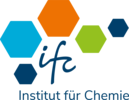Contact
Mailing Address
Visitors
Scanning Force Microscopy (SFM) or Atomic Force Microscopy (AFM)
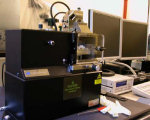
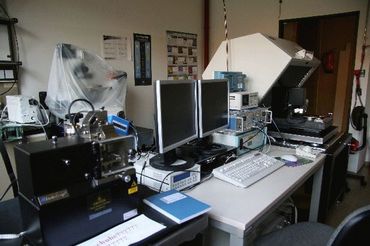
Instrumentation
Controller: Nanoscope IIIA (Veeco), Quadrex Extension Box
Messköpfe: Dimension 3100, Enviroscope, Bioscope (alle Veeco)
Erweiterungen: Pulsed force mode (Witec), Leitfähigkeitserweiterung (Veeco)
Spezialanwendungen: Arbeit in Lösung, Arbeit in kontrollierten Gasatmosphären, große Proben
Contact Mode and Tapping Mode
In our group the contact mode and the Tapping mode are used for determiknation of the topography of a sample. In the contact mode, the tip is brought in close contact to the sample. The pressure between tip and sample is measured by the deflection of the cantilever at which the tip is attached.. This pressure is kept konstant by a feedback loop that changes the vertical position of the cantilever.
For working in teh Tapping mode, the cantilever is excited to mechanical vibration close to its resonance frequence (ca 10-500 kHz) using a piezoelectric ceramic. If the tip approaches the sample, the amplitude of the vibration is lowered by the interaction between tip and sample. A feedback loop keeps the apmplitude constant ba changing the z-coordinate. By plotting z vs (x, y) coordinates, a topographic image of the sample is obtained. Both mpodes can be operated in air, in liquids and in a vacuum.
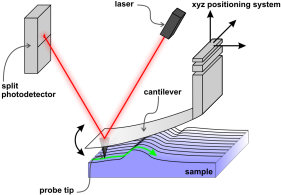
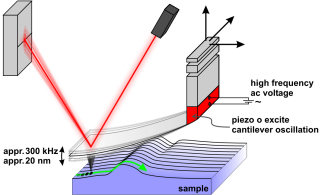
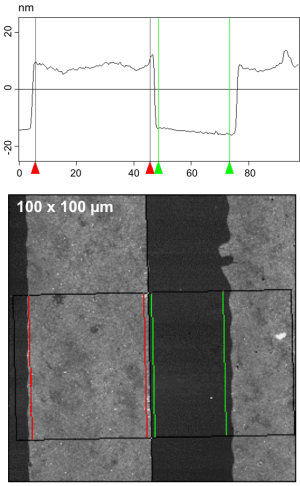
Material Properties: Pulse Force Mode and Lateral Force Mode
In the pulsed force mode, the z-Position of the piezo is modulated by a sine function (ca. 300 – 1000 Hz) in such a way that the tip oscillates between freely suspended and pressed against the sample. During the movement the develection of the cantilever is continously monitored. The analysis of resulting approach and retract curves provides information about the local stiffness of the sample and local adhesion between tip and sample.
The lateral force mode is a variation of the contact mode. The fast scan direction is roatted by 90° to move the cantilever perpendicular to its longer extension. Due to friction forces between the sample and the tip, the cantilever is distorted. The distortions varies with the „stickiness” of the sample and can be measured by a laser beam directed on a 4-segment photodiode. Form this data a mapping of the local fristion forces can be assembled.
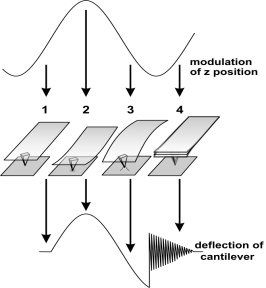
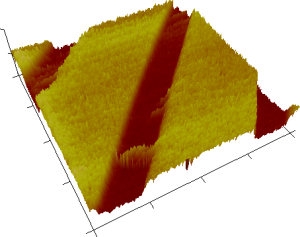
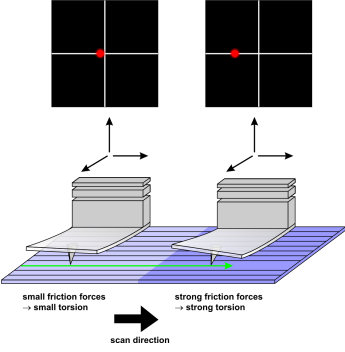
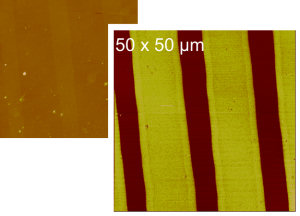
Conductive Atomic Force Microscopy (CAFM)
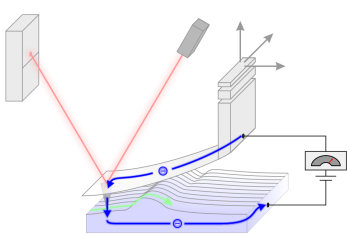
Conductive atomic force microscopy (CAFM) has evolved from the contact mode. A potential difference is applied between a conductive AFM tip and the sample. The current is messured in addition to the deflection signal. The change of the current provides information about the local conductivity of the sample. Those data can be correlated to the topography measured simultaneously in the same was as in the contact mode.
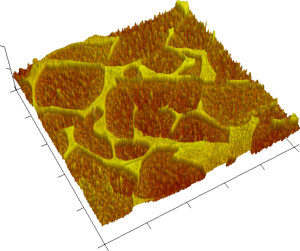
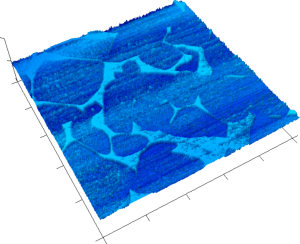
Full background and details to this experiment and sample:S. E. Pust, D. Scharnweber, C. Nunes Kirchner, G. Wittstock; Heterogeneous Distribution of Reactivity on Metallic Biomaterials: Scanning Probe Microscopy Studies of the Biphasic Ti Alloy Ti6Al4V. Adv. Mater. 2007, 19, 878-882. Abstract & Link



